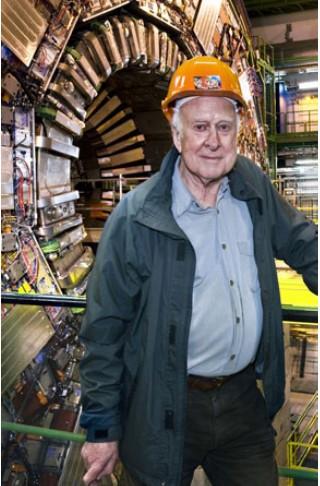
Science and Technology
科技
Looking for the Higgs
捕獲希格斯粒子
Enemy in sight?
敵軍現(xiàn)身?
The search for the Higgs boson is closing in on its quarry
希格斯玻色子的研究逼近其目標(biāo)
ON JULY 22nd two teams of researchers based at CERN, Europe's main particle-physics laboratory, near Geneva, told a meeting of the European Physical Society in Grenoble that they had found the strongest hints yet that the Higgs boson does, in fact, exist.
7月22日,駐歐洲粒子物理研究所(CERN,鄰近日內(nèi)瓦的歐洲主要粒子物理實(shí)驗(yàn)室)的兩組研究人員在格勒諾布爾(Grenoble)歐洲物理協(xié)會(huì)的一次會(huì)議上聲稱(chēng),他們已經(jīng)得到迄今為止最有力的線(xiàn)索,將力證希格斯玻色子的確真實(shí)存在。
The Higgs (named after Peter Higgs, a British physicist who predicted its existence) is the last unobserved part of the Standard Model, a 40-year-old theory which successfully describes the behaviour of all the fundamental particles and forces of nature bar gravity.
希格斯粒子(它以預(yù)言其存在的英國(guó)物理學(xué)家彼得·希格斯的名字命名) 是"基礎(chǔ)模型"中最后一個(gè)尚未觀測(cè)到的組件,"基礎(chǔ)模型"已有40年的歷史,它成功地描述了所有基礎(chǔ)粒子的行為及除重力以外的所有自然力。
Mathematically, the Higgs is needed to complete the model because, otherwise, none of the other particles would have any mass.
在數(shù)學(xué)層面上,希格斯粒子對(duì)于完成"模型"是必不可少的,這是因?yàn)椋坏┤鄙偎械钠渌W佣紝?huì)失去質(zhì)量。
The problem with the elusive boson is not creating it in the first place.
對(duì)于難于捉摸的玻色子而言,首要的問(wèn)題并不是將其創(chuàng)造出來(lái)。
Two of the world's particle accelerators, the Large Hadron Collider (LHC) at CERN and its American rival, the Tevatron at Fermilab on the outskirts of Chicago, each have more than enough oomph to conjure up the Higgs—at least if it looks anything like theory suggests it should.
世界上現(xiàn)有兩臺(tái)粒子加速器,歐洲粒子物理研究所的大型強(qiáng)子對(duì)撞機(jī)(LHC),以及其美國(guó)競(jìng)爭(zhēng)對(duì)手芝加哥市郊費(fèi)米實(shí)驗(yàn)室的兆電子伏加速器(Tevatron),各自都有綽綽有余的充沛魔力去召喚希格斯粒子——如果一切符合理論,至少看來(lái)應(yīng)該是這樣。
The difficulty, rather, is spotting signs of it in the jetsam of subatomic debris these machines produce.
然而,困難在于如何在這些機(jī)器制造的亞原子碎片衍生物中辯認(rèn)出它的蹤跡來(lái)。
Both laboratories use similar approaches: smashing particles called hadrons into each other.
兩個(gè)實(shí)驗(yàn)室都采用類(lèi)似的方法:將稱(chēng)作強(qiáng)子的高能粒子彼此對(duì)撞。
The LHC collides beams of protons.
大型強(qiáng)子對(duì)撞機(jī)對(duì)轟質(zhì)子束。
The Tevatron works with protons and antiprotons.
而兆電子伏加速器使用的是質(zhì)子和反質(zhì)子。
In each case the particles concerned are accelerated to within a whisker of the speed of light before they are forced, head-on, into each other.
在它們被強(qiáng)制彼此迎頭撞擊之前,各自所采用的那些粒子都要被加速至距離光速僅有一線(xiàn)之隔。
During such a collision, their kinetic energy is converted into other particles (since, as Einstein showed, energy and mass are but two sides of the same coin).
在這樣的撞擊過(guò)程中,它們的動(dòng)能轉(zhuǎn)換成額外的粒子(正如愛(ài)因斯坦所指出的那樣,這是由于能量和質(zhì)量只是同一個(gè)硬幣的兩面而已)。
The more kinetic energy there is, the heavier these daughter particles can be.
動(dòng)能越大,越能產(chǎn)生更大質(zhì)量的粒子。
Unfortunately hadrons, such as protons and antiprotons, are made of smaller bits called quarks.
不幸的是,強(qiáng)子,比如質(zhì)子和反質(zhì)子,是由名為夸克的更小單元所組成的。
As a result, hadron collisions can be messy and difficult to interpret.
結(jié)果,強(qiáng)子的撞擊可能造成混亂且難于預(yù)測(cè)的局面。
If a Higgs were to be made in such a collision, the complexity of hadrons means that other particles would be created along with the boson.
如果一個(gè)希格斯粒子產(chǎn)生在這樣的一次碰撞中,那么強(qiáng)子的復(fù)雜構(gòu)造意味著另外的粒子也將會(huì)伴隨這個(gè)玻色子而出現(xiàn)。
Both it and its companions would then decay almost instantly into a plethora of less fleeting bits, some of which could be detected.
玻色子與它的伙伴們將會(huì)幾乎在瞬間衰變?yōu)榇笈鷫勖痰奈⒘W樱渲杏幸恍┠鼙粰z測(cè)出來(lái)。
In theory, analysing this shower of daughter particles should give away whether or not a Higgs was involved.
理論上,分析這批衰變所產(chǎn)生的粒子應(yīng)該能輕松查明是否其中曾存在希格斯粒子。
But other sorts of subatomic process that do not involve the Higgs can produce precisely the same final readings as those the missing boson is predicted to generate.
然而其他類(lèi)型的不含希格斯粒子的亞原子衰變過(guò)程也能夠精確地產(chǎn)生相同的最終觀測(cè)結(jié)果,就跟缺失的希格斯粒子預(yù)定產(chǎn)生的一般。
Finding a Higgs-like signal among the daughters is therefore not, by itself, enough to say you have discovered the Higgs.
因而在這些衍生粒子中發(fā)現(xiàn)類(lèi)似希格斯粒子的跡象本身并不足以證明你已經(jīng)發(fā)現(xiàn)希格斯粒子。
What is needed is an unexpected abundance of such signals.
這樣的跡象出乎意料地頻繁出現(xiàn)是一個(gè)必要條件。
And it is just such excess that two separate experiments at the LHC, known as CMS and ATLAS, have detected.
而在大型強(qiáng)子對(duì)撞機(jī)上的這兩個(gè)獨(dú)立實(shí)驗(yàn)(稱(chēng)為CMS和ATLAS)就已經(jīng)檢測(cè)到這樣的反常頻密現(xiàn)象。
Individually, each team's result could be a statistical fluke.
客觀地說(shuō),每個(gè)研究團(tuán)隊(duì)所得出的結(jié)論可能只是統(tǒng)計(jì)意義上的偶然現(xiàn)象。
Neither reaches the exacting standard of proof that particle physicists require to accept a result unequivocally—namely one chance in 3.5m that it occurred by accident.
兩者都達(dá)到粒子物理學(xué)家所提出能確定無(wú)疑地接受為證據(jù)的嚴(yán)苛標(biāo)準(zhǔn)——即三百五十萬(wàn)次實(shí)驗(yàn)中偶爾發(fā)生一次。
Instead, they each achieved a significance of somewhere between one chance in 1,000 and one in six, depending on which statistical test you use.
不止如此,它們各自都獲得了顯著的觀測(cè)數(shù)據(jù),從一千次發(fā)生一次到六次發(fā)生一次的范圍之內(nèi),這取決于你所采用的統(tǒng)計(jì)學(xué)測(cè)試標(biāo)準(zhǔn)。
What set the scientists gathered in Grenoble aflutter, though, was that both experiments ascribed the excesses they observed to the same putative decay pattern—one involving W bosons, which mediate the weak nuclear force that is responsible for certain types of radioactive decay.
令到聚集在格勒諾布爾的科學(xué)家們興奮不已的是,這兩個(gè)實(shí)驗(yàn)中所觀察到的反常頻密現(xiàn)象都要?dú)w因于相同的公認(rèn)衰變模式——一種涉及W玻色子的衰變,該玻色力是傳遞弱核力的媒介,而弱核力是某些特定種類(lèi)放射性衰變的主因。
Both teams also ascribe the same mass to their putative Higgses, namely 130-150 gigaelectron-volts (the units in which particle physicists measure mass).
兩個(gè)團(tuán)隊(duì)也認(rèn)為他們所推定的希格斯粒子具有相同的質(zhì)量,即130—150吉電子伏特(這是粒子物理學(xué)測(cè)量質(zhì)量所采用的一種單位)。
That is at the low end of the predicted range.
這處在預(yù)測(cè)范圍中的底部。
Sadly, even taken together these results are far from robust enough to claim the Higgs's discovery.
遺憾地是,即使是將這些結(jié)果一并考慮,也遠(yuǎn)不足于斬釘截鐵地?cái)嘌园l(fā)現(xiàn)希格斯粒子。
With a little tweaking, the Standard Model might explain them in other ways.
只要稍作更改,"標(biāo)準(zhǔn)模型"可以用另一種方式去解釋它們。
Guido Tonelli and Fabiola Gianotti, who head CMS and ATLAS respectively, therefore urge caution.
各自領(lǐng)導(dǎo)CMS和ATLAS的基多·湯內(nèi)利(Guido Tonelli)及法比奧拉·賈諾蒂(Fabiola Gianotti)因而呼吁要格外的小心謹(jǐn)慎。
Their goal is to have enough data by the end of the year either to say definitely that the Higgs has a mass of 130-150 gigaelectron-volts, or that if it exists at all, then it must be heavier than that.
他們的目標(biāo)是到今年年末獲得足夠的數(shù)據(jù),要么證明希格斯粒子具有130—150吉電子伏特的質(zhì)量,要么證明只要它確實(shí)存在,那么它必定要更重一些。
If this is the case, the hunt will continue at higher and higher energies (and therefore masses) until either the thing is found, or there is nowhere left in the energy landscape for it to be hiding.
如果是這樣的話(huà),追捕行動(dòng)將在越來(lái)越高的能量(因此質(zhì)量也是同樣如此)層級(jí)上展開(kāi),直到發(fā)現(xiàn)它為止,否則的話(huà),能量圖譜中根本就不存在它的藏身之處。



